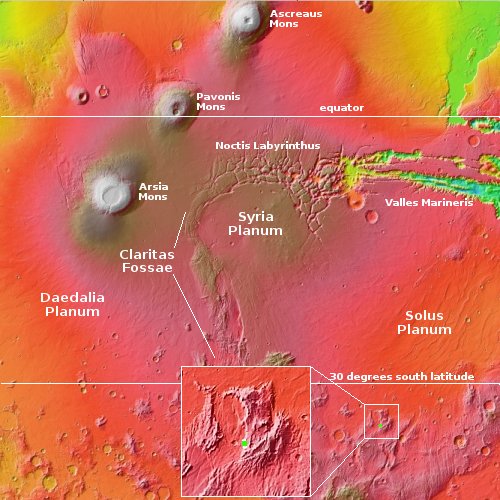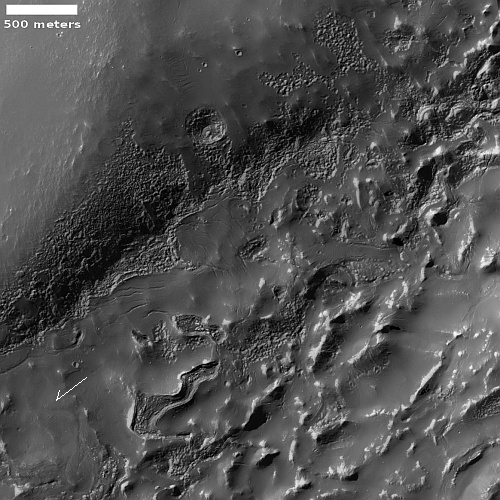Eroding glacier on Martian slope?
Cool image time! The picture to the right, enhanced, cropped, reduced, and sharpened to post here, was taken on April 1, 2023 by the high resolution camera on Mars Reconnaissance Orbiter (MRO). It shows what the science team labels as “Rough Ground and Bright Exposures” on the flanks of a wide mountain range on Mars, whose highest point is about 4,400 feet higher to the northeast and about 30 miles away.
The arrow indicates the downhill grade. Notice the smooth flat areas that seem to only partially cover much rougher terrain below. To my eye this top layer resembles an Earth glacier that has partly sublimated or melted away, exposing the rougher bedrock below that has been ground and scraped by the glacier previously.
However, this is not on Earth, so assuming it is like an Earth glacier is dangerous.

The green dot in the inset on the overview map to the right marks the location of this rough ground. At 33 degrees south latitude, it is definitely possible on Mars that we are looking at glacier material, though this latitude is close enough to the equator that the presence of near-surface ice is usually reduced.
The high altitude, located as it is on the Tharsis Bulge, might also change things. On Earth higher elevations increases the amount of ice. On Mars it likely does the opposite, because the atmosphere becomes even thinner and is likely unable to transport water vapor to such locations, at least not in the amounts seen at lower elevations.
These factors might explain the eroded nature of the glacier-like top layer. It is slowly vanishing, not by human-caused global warming (that according to some activists is the root of all evil), but by the generally inhospitably Martian environment to ice at this latitude and high altitude.
One more note: I have no idea what the bright exposures are. It is possible they are exposed ice, no longer covered by a protective layer of dust and debris. It is also possible they are some form of light-colored bedrock. As these bright areas tend to be at high points, it suggests wind is acting to reveal them, one way or the other.
On Christmas Eve 1968 three Americans became the first humans to visit another world. What they did to celebrate was unexpected and profound, and will be remembered throughout all human history. Genesis: the Story of Apollo 8, Robert Zimmerman's classic history of humanity's first journey to another world, tells that story, and it is now available as both an ebook and an audiobook, both with a foreword by Valerie Anders and a new introduction by Robert Zimmerman.
The print edition can be purchased at Amazon or from any other book seller. If you want an autographed copy the price is $60 for the hardback and $45 for the paperback, plus $8 shipping for each. Go here for purchasing details. The ebook is available everywhere for $5.99 (before discount) at amazon, or direct from my ebook publisher, ebookit. If you buy it from ebookit you don't support the big tech companies and the author gets a bigger cut much sooner.
The audiobook is also available at all these vendors, and is also free with a 30-day trial membership to Audible.
"Not simply about one mission, [Genesis] is also the history of America's quest for the moon... Zimmerman has done a masterful job of tying disparate events together into a solid account of one of America's greatest human triumphs."--San Antonio Express-News
Cool image time! The picture to the right, enhanced, cropped, reduced, and sharpened to post here, was taken on April 1, 2023 by the high resolution camera on Mars Reconnaissance Orbiter (MRO). It shows what the science team labels as “Rough Ground and Bright Exposures” on the flanks of a wide mountain range on Mars, whose highest point is about 4,400 feet higher to the northeast and about 30 miles away.
The arrow indicates the downhill grade. Notice the smooth flat areas that seem to only partially cover much rougher terrain below. To my eye this top layer resembles an Earth glacier that has partly sublimated or melted away, exposing the rougher bedrock below that has been ground and scraped by the glacier previously.
However, this is not on Earth, so assuming it is like an Earth glacier is dangerous.

The green dot in the inset on the overview map to the right marks the location of this rough ground. At 33 degrees south latitude, it is definitely possible on Mars that we are looking at glacier material, though this latitude is close enough to the equator that the presence of near-surface ice is usually reduced.
The high altitude, located as it is on the Tharsis Bulge, might also change things. On Earth higher elevations increases the amount of ice. On Mars it likely does the opposite, because the atmosphere becomes even thinner and is likely unable to transport water vapor to such locations, at least not in the amounts seen at lower elevations.
These factors might explain the eroded nature of the glacier-like top layer. It is slowly vanishing, not by human-caused global warming (that according to some activists is the root of all evil), but by the generally inhospitably Martian environment to ice at this latitude and high altitude.
One more note: I have no idea what the bright exposures are. It is possible they are exposed ice, no longer covered by a protective layer of dust and debris. It is also possible they are some form of light-colored bedrock. As these bright areas tend to be at high points, it suggests wind is acting to reveal them, one way or the other.
On Christmas Eve 1968 three Americans became the first humans to visit another world. What they did to celebrate was unexpected and profound, and will be remembered throughout all human history. Genesis: the Story of Apollo 8, Robert Zimmerman's classic history of humanity's first journey to another world, tells that story, and it is now available as both an ebook and an audiobook, both with a foreword by Valerie Anders and a new introduction by Robert Zimmerman.
The print edition can be purchased at Amazon or from any other book seller. If you want an autographed copy the price is $60 for the hardback and $45 for the paperback, plus $8 shipping for each. Go here for purchasing details. The ebook is available everywhere for $5.99 (before discount) at amazon, or direct from my ebook publisher, ebookit. If you buy it from ebookit you don't support the big tech companies and the author gets a bigger cut much sooner.
The audiobook is also available at all these vendors, and is also free with a 30-day trial membership to Audible.
"Not simply about one mission, [Genesis] is also the history of America's quest for the moon... Zimmerman has done a masterful job of tying disparate events together into a solid account of one of America's greatest human triumphs."--San Antonio Express-News


